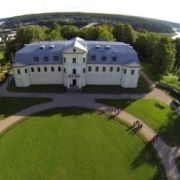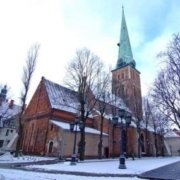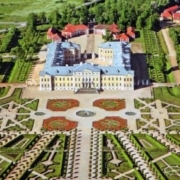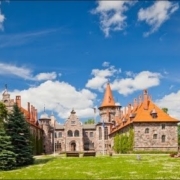Cathedral of the Nativity
Cathedral of the Nativity
 The need to build a new cathedral in Riga was discussed at the end of the 18th century. But the practical implementation of this idea began to be realized only after a hundred years. With the blessing of the Bishop of Riga and Mitava, Benjamin (Karelin), in the seventies of the 19th century, collection of donations for the future church began. Six months later, Prince Bagration, being the Governor General of the Baltic Region, sent a petition to the Minister of Internal Affairs of Russia to build a worthy cathedral in Riga.
The need to build a new cathedral in Riga was discussed at the end of the 18th century. But the practical implementation of this idea began to be realized only after a hundred years. With the blessing of the Bishop of Riga and Mitava, Benjamin (Karelin), in the seventies of the 19th century, collection of donations for the future church began. Six months later, Prince Bagration, being the Governor General of the Baltic Region, sent a petition to the Minister of Internal Affairs of Russia to build a worthy cathedral in Riga.
Nature itself “joined” the petition. September 1, 1873 a storm broke out over Riga. One of the lightning strikes fell on Petro – Pavlovsky Cathedral. Collapsed the top cornice of the bell tower. Fire destroyed part of the painting. In many places, gilding disappeared. The windows were left without windows. The cathedral, which was already extremely cramped and modest in decoration, began to require significant repairs.
This fact accelerated the resolution of the issue. On April 17, 1874, at the behest of Alexander II, the Diocese of Riga was allocated 900 thousand rubles.
At this time, three famous Riga architects J.-F. Bauman, G. Schel and R. Pflug have already completed work on their projects for the future cathedral.
Each project took place in Riga, St. Petersburg and Moscow with a competent expert assessment. As a result, in December 1875, on the project of Academician Pflug, the resolution of Alexander II was inscribed: “Proceed to the construction …”
Construction was commissioned on a competitive basis. Preference was given to the Vilnius provincial architect, academician Chagin.
The consecration of the bookmark of the cathedral took place on July 3, 1876. The first stone in the future building was laid by the bishop of Riga and Mitava Seraphim (Protopopov).
By the beginning of the 80s of the XIX century, the construction of the building was almost completed. But at this time, Alexander III sent 12 bells to the temple as a gift. The largest, in the name of Alexander Nevsky, weighed more than 800 pounds. Each bell was an outstanding work of art casting. They were cast at the factory of the Moscow merchant Nikolai Dmitrievich Finland. The bell was cast by one of the outstanding masters of the late 19th century Xenophon Verevkin.
This ensemble of bells required a special architectural solution for their placement. R. Pflug was commissioned with additional design. The architect’s project was very successful. The bell tower above the main entrance to the temple created a special perspective. Performed in a single architectural style with the cathedral, it gave great volume to a very tall building as a whole.
Eight years later, the construction of the temple was completely completed. April 24, 1884 he was transferred to the jurisdiction of the spiritual department. And on Saturday, October 27, 1884, the first ringing of all 12 bells of the Cathedral of the Nativity of Christ the Savior was heard over Riga for the first time.
Soon the Riga Cathedral became the universally recognized spiritual center of not only Riga, but the whole region. Many prominent representatives of the clergy take part in its activity. In a number of sources, information has been preserved that in September 1894, Archpriest John of Kronstadt, who was now considered a saint, performed the service here.
At the head of the multilateral activities of the cathedral were its abbots. The first of them is Archpriest V. S. Knyazev. Professor of church-biblical history, canon law and church archeology, he contributed in every way to enriching the spiritual, moral and aesthetic level of the church’s activity, wider involvement of Orthodox Riga residents in the history of culture, and original traditions.
In the first decade of the 20th century, Archpriest V. I. Plis, teacher of the Riga Theological Seminary, is appointed the rector of the cathedral. Thanks to outstanding representatives of the clergy and highly educated residents of Riga, the prestige of the cathedral was exceptionally high, especially since the services were performed here in four languages: Church Slavonic, Latvian, Estonian and German.
According to contemporaries, every visit to the cathedral brought people peace of mind, the joy of a highly spiritual state. To a large extent this was facilitated by the special inner atmosphere of the temple, its decoration, the general harmony of everything around.
Carved iconostases and choirs had a single artistic solution. They were decorated with patterned columns, a gilded ornament of cast zinc, and unique wood carvings. Of particular artistic value were openwork gilded gates of the main aisle. Church utensils fit into the general style of the cathedral. All her items were made of silver of the 84th test by skilled craftsmen of the Moscow manufacturer Khlebnikov.
For several years the sacristy of the cathedral was created. The vestments of the clergy sewed the best gold seamstresses of the brocade workshop of the St. Petersburg merchant Zheverzheev. Unfortunately, the authors and performers of these unique products have remained unknown.
A truly priceless treasure of the Cathedral of the Nativity of Christ the Savior was his collection of icons. They were performed on canvas and zinc, white metal and cypress wood. They were written on a golden background, focusing on samples of ancient church painting. Many people donated icons to the cathedral and personally participated in the enrichment of this outstanding collection of icon paintings, some of which have been preserved since the founding of the Diocese of Riga (1850).
The icons of the earliest writing included those that were transferred by a procession from the Peter and Paul Cathedral on the day of the consecration of the new cathedral. A significant part of the icons was commissioned by the construction committee. Outstanding artists became their authors. Brushes of V.V. Vereshchagin belonged to the church icons “Nativity of Christ”, “Nativity of the Blessed Virgin Mary” and “St. Alexander Nevskiy”. He was also the author of the icons of the first tier of the main iconostasis and the Royal Doors.
The icons of the second and third tiers of the main iconostasis were painted by the artist Vasiliev. Among the works of K. Shamshin, the icons “The Virgin and Child” and “John the Baptist” are known.
Among the donors of the icons were not only Riga residents, but also residents of many other places, in particular St. Petersburg and Moscow.
It is known that in the main and additional church and sacristy inventories 850 items were listed. All of them had church, historical, artistic and material value. These included church painting, liturgical books, vestments, miter, carpets, and much, much more. A significant part of these unique values was donated by Riga residents. There were so many Riga benefactors that it was not possible to name all of them. Gifts came from Riga merchants, high society circles, and various societies.
In general, more than half a million rubles were spent on the construction of the cathedral. The internal arrangement cost 140,212 rubles 87 kopecks. This at a time when a pound (400 g) of bread was worth 2 kopecks, and meat – 15, a thousand times cheaper than now, silver.
The tragic turn in the fate of the temple began in the First World War. In 1918, the Riga Municipality actually closed the cathedral. Worship in it was forbidden. And when Archbishop John Pommer arrived in Latvia at the invitation of the All-Latvian Council of Orthodox Parishes, he found the church in disastrous condition.
Windows without glass. The bell tower without its unique bells. The decoration is defiled. Dear, artwork, the iconostases are warped, piled in a heap. Damaged painting, crucifix thrown into the trash. Everything that was valuable disappeared. To this day, they still argue about who is to blame and where the most valuable monuments of Orthodox church art and centuries-old culture have gone. There are many versions, but little has been returned.
The difficult path to resurrection began with the fact that His Eminence Archbishop John (Pommer), in order to prevent the further destruction of the church, to collect everything that remained and could be put in order, restored, settled in the basement of the cathedral. The stove was folded for heating. Gradually, at the cost of considerable efforts and hard struggle, the restoration of the temple began. The residents of Riga helped those Russians who suddenly became emigrants, lost everything, lost their roof over their heads.
The activity of the cathedral was resumed with difficulty. At first, a special permission of the authorities was required for each service. And only from Christmas 1922 the cathedral began its daily service. The service was performed in Church Slavonic and Latvian languages.
By the mid-30s, the cathedral was put in order, the painting was updated. There was a stubborn struggle for the return of the former property of the cathedral, including icons, church utensils. The temple again became the spiritual center of Riga.
A new blow was dealt by the Second World War. Again the ruin and resurrection of the cathedral again. After the war, ordinary spiritual life went on. The Cathedral continued to be a spiritual pillar for many, many people who knew the horrors and troubles of this monstrous war.
But the fact that the two world wars and the revolution did not destroy was ruined in the 60s. By order of the Council of Ministers on October 5, 1963, the cathedral was closed. This time everything was destroyed and taken away. From the cathedral there were only walls. But they are also mutilated, they are covered with reinforced concrete, and floors are made. Build and remodel the internal space, destroying the painting. Dealers from “knowledge” turn the temple into a profitable place and have been exploiting it for thirty years.
Only in July 1991 did the difficult path to resurrection begin. Almost five years was dismantling. The difficulty was that the ceiling, unknown as laid, posed a threat to the walls of the building itself. Not only significant funds were required, but also extreme caution. Of particular difficulty was the restoration of the central dome.
The spiritual life of the cathedral began in difficult conditions on January 6, 1992, when His Eminence Vladyka Alexander performed the first service. Since then, regular worship services have begun. At the same time, with incredible difficulties, but continuously, day after day, restoration work was carried out. Every step in this direction from year to year is given with great difficulty. Now the Cathedral is beautifully painted. All domes are covered with copper, a new roof is made. Gilded cross on the central dome. But much remains to be done.
Families of benefactors Vladimir Ivanovich Malyshkov and Igor Vladimirovich Malyshkov donated a beautiful iconostasis.
Through the efforts of many, many people, the triple-risen “Riga”, as it is popularly called, the Nativity of Christ Cathedral, has already found its rightful place in the spiritual and cultural life of Latvia.
Information taken from the official website of the Riga Cathedral – http://sobor.lv/












Leave a Reply
Want to join the discussion?Feel free to contribute!